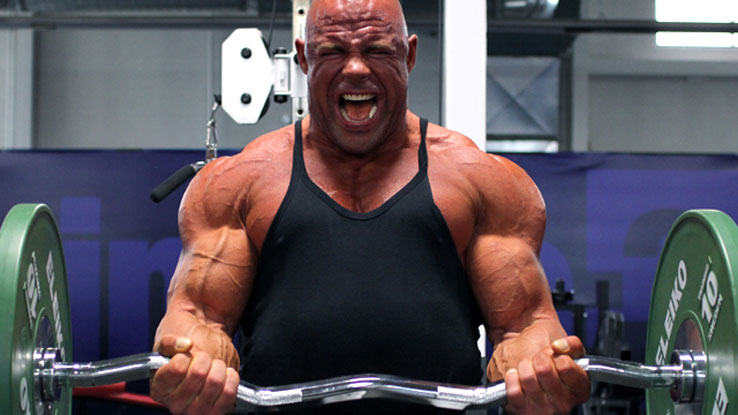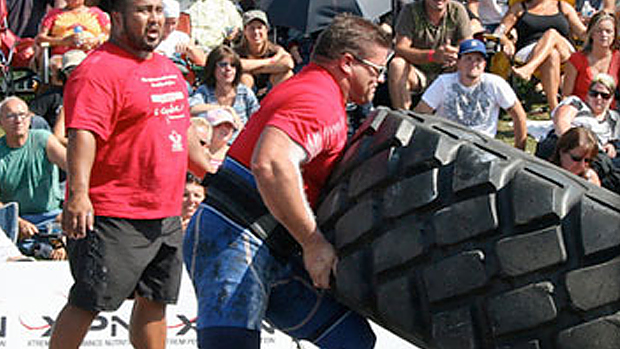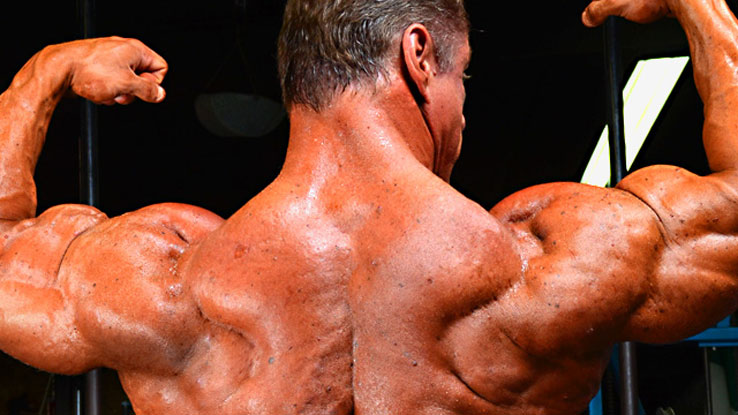If you're reading this article, I'll bet I know a few things about you.
First, you probably have two overriding goals when it comes to weight training – you wanna be big, and you wanna be strong. And by "big," what I mean is that you want to look the part – muscular and lean.
Second, I'm betting that you feel torn between these two goals. In other words, on one shoulder you have a muse telling you, "Screw what you look like, all that matters is what you can do!"
And of course on your other shoulder, another voice is telling you, "No one knows what you can lift, all they know is what you look like."
I know these things about you because, well, we're all chasing those goals, and we all feel conflicted about pursuing two objectives simultaneously.
Although there are exceptions, most bodybuilders admire the amazing strength of powerlifters, strongmen, and weightlifters, and most strength athletes want a physique that reflects their capabilities.
Before I outline the training split that's the subject of this article, I'll point out a few current examples from a recent crop of guys who are tackling these twin goals very successfully.
Stan Efferding

At age 45, "The Rhino" is an IFBB pro as well as a record-setting raw powerlifter who boasts numbers that make equipped lifters scratch their heads in wonder.
With an 854-pound squat and a 2303-pound total in the 275-pound class, big Stan is on the verge of hitting a 900-pound squat as well. Needless to say, Stan's training approach successfully merges hypertrophy and pure strength training.
Layne Norton

Layne is another amazing lifter with the physique to match. Layne's best lifts include a 617-pound squat, a 386-pound bench press, and a 700-pound deadlift, all done as a raw lifter in the 220-pound class.
His best single meet 3-lift total is 1680 pounds. This total has placed Layne in the Elite Raw Total classification in powerlifting.
Layne's no slouch in the sport of bodybuilding, either. Among numerous other titles, he was the heavyweight winner at the 2010 IFPA Pro International.
As it turns out, Layne has written extensively about a training split called "PHAT" (Power Hypertrophy Adaptive Training), which has a lot of resemblance to, and operates on some of the same premises as, the split that I'm presenting here.
Fatigue Specificity Explained

In at least two very specific ways, an argument can be mounted that pursuing the twin goals of strength and hypertrophy are in fact superior to chasing only one of these goals.
First, strength training and hypertrophy training do not detract from one another. Truth is, each supports the other.
If you want to be stronger, you simply can't get around the fact that a thicker muscle fiber can generate more force than a thinner fiber, all else being equal.
And if you want more muscle, you need to train your brain (the motor cortex specifically) to recruit more muscle fibers during intense efforts, which is what happens when you train for strength.
Think of it like a car engine. To win the race, you want the biggest engine you can get (analogous to the number of cylinders it has), but you also want that engine firing as smoothly as possible (which equates to nervous system contributions).
The second rationale for concurrent strength and hypertrophy relates to fatigue specificity. Put simply, the fatigue generated from one type of activity/body region has a greater negative effect on subsequent similar activities than it has for subsequent differing activities.
So in other words, an upper body maximum strength session will negatively affect a subsequent upper body maximum strength workout more than it would negatively affect a subsequent lower body maximum strength session.
Still with me? Obviously, the more frequently you can train, the faster you'll progress. And the way to train as frequently as possible is to make each workout as dissimilar as possible from the one that preceded it and the one that will follow it.
In other words, if you only did upper-body hypertrophy workouts, your training frequency would be limited by fatigue specificity. On the other hand, if you did upper body strength and upper body hypertrophy sessions, you'd be able to train more frequently while still making progress. Add in lower body sessions for strength and hypertrophy and you can train even more frequently.
The Strength/Hypertrophy Split:
Here's how I've been following this split myself. Afterwards, I'll provide a few variations you can consider based on your unique requirements.
| Monday | Wednesday | Friday | Saturday |
| Upper | Lower | Upper | Lower |
| Strength | Strength | Hypertrophy | Hypertrophy |
| Bench Press | Squat | Dumbbell Bench | Cambered Squat |
| Chins | Deadlift | Rows | Hip Thrust |
| Triceps Extension | Military Press | Back Extension | |
| EZ-Bar Curl | Dumbbell Curl | 45° Back Extension |
- Although Monday is designated as a strength day, usually only the bench press (but sometimes chins as well) is trained using maximum strength parameters.
- Biceps and triceps movements, being uni-articular exercises, aren't typically trained with very low rep sets for safety reasons.
- Taking a tip from Andy Bolton, I now train squats and deadlifts on the same day since that's how I must perform them in competition. Because these two lifts take a heavy toll on the nervous system, however, I don't perform any additional movements on this day.
- All exercises on Friday are done in the 6-10 repetition range to accommodate the requirements for hypertrophy stimulation and to build work capacity.
- Saturday starts with squats, but done for higher reps (5-10) on a cambered bar, which saves the shoulders and presents a slightly different movement angle than squats done with a straight bar. After that, I shift to posterior chain movements, which are not particularly taxing and can be performed with minimal setup and warm-ups.
- If you simply can't train 4 days a week, this split can be adapted to a 3-day training week. Simply follow the four workouts in the same order in which they were presented, but spread over a 3-day week template. Therefore, the Saturday session above would actually happen on the following Monday, and so on.
Fine Tuning the Strength/Hypertrophy Split
- Some of my exercises are predicated upon the fact that I compete in raw powerlifting competitions, as well as my own unique strengths and weaknesses. As long as you preserve the original intent of the split, there's no problem with exercise substitutions.
- You can plug in whatever loading strategies you prefer for strength and hypertrophy adaptations. If you like 5 x 5, or Chad Waterbury's 25 System, or Pavel's ladders, or any other valid system, then use it. The fact is I recommend regularly rotating your loading strategies to prevent acclimation to the program.
- Powerlifters and other strength athletes should view Fridays and Saturdays as "Assistance" exercise days. Meaning, choose these exercises based on improving weaknesses in your main competitive lifts.
However, I still recommend doing these exercises using loading strategies that will maximize hypertrophy. This means relatively high volume, but it doesn't necessarily mean high-rep sets. As Chad Waterbury and others have argued, 10 x 3 can be just as effective as 3 x 10, if not more so.
Those who don't compete in strength sports should nevertheless adopt a powerlifter mentality on their two strength-focus days. Perform several sets of low (1-3 reps), taking plenty of rest between sets to allow for optimal inter-set recovery. You won't be huffing and puffing, nor will you be sweating – you can save that type of pain for your hypertrophy days.
An argument can be made for the idea of using a slightly different rotation than the one presented above; one that looks like this:
| Monday | Wednesday | Friday | Saturday |
| Upper | Lower | Upper | Lower |
| Strength | Hypertrophy | Hypertrophy | Strength |
The rationale for this is that it represents an even greater level of divergence between successive workouts than the first split. In the end, however, both iterations work very well.
Inevitably, the issue of cardio will always come up, so let me address that proactively. First, if body composition is your rationale for considering the addition of cardio, try to fine-tune your nutrition first, saving cardio as a last resort.
If and when you do arrive at that last resort, however, keep your cardiovascular excursions on the very low or the very high end of the intensity scale.
L.I.S.S (Low Intensity Steady-State) activities such as walking help to burn calories without affecting your recovery from weight-training.
H.I.I.T. (High Intensity Interval Training) sessions can also be performed, but they have similar recovery requirements as weight-training sessions. The good thing is that even very brief H.I.I.T sessions can significantly increase your metabolic rate, resulting in some serious fat burning.
What you don't want to do however is "M.I.S.S" (Medium Intensity Steady-State, i.e., "aerobic" work), which is a relatively poor metabolic stimulator and may also disturb the signals necessary for hypertrophy development.
You Can Have It Both Ways
Training for strength and mass really doesn't follow the old adage "jack of all trades, master of none." Really, you're just going to be a jack of two trades, and very complementary trades at that.
The concept of "interference" really only applies to the concurrent pursuit of highly divergent goals, such as maximum power and aerobic endurance, for example.
Strength and hypertrophy are close cousins in the adaptation department, and as I've just shown, your overall training results will be ultimately enhanced – if you plan your training intelligently.
If you have experience using similar splits, or have questions about what's presented here, please make your thoughts known in the LiveSpill below. I'd love to help you get the best possible results from this great training split.





